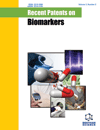- Home
- A-Z Publications
- Recent Patents on Biomarkers (Discontinued)
- Previous Issues
- Volume 5, Issue 2, 2015
Recent Patents on Biomarkers (Discontinued) - Volume 5, Issue 2, 2015
Volume 5, Issue 2, 2015
-
-
Patents in Oxidative Stress in Preeclampsia
More LessBy Kharb SimmiPreeclampsia is a major cause of maternal and fetal morbidity and mortality and its prediction, diagnosis and management still remain to be challenging. However, recent technological advances in the understanding of its pathophysiology have identified many biomarkers to aid prediction of women at risk of developing preeclampsia (PE). Many etiological factors for PE have been evaluated as biochemical markers in the m Read More
-
-
-
Urinary Cytokines as Biomarkers in Glomerular Diseases
More LessAuthors: Maria J. Stangou and Aikaterini PapagianniDiagnosis of glomerular diseases is based on renal biopsy, an invasive method that offers information about the type and severity of renal damage and predicts renal function outcome. Types of glomerulonephrities differ in etiology, pathogenesis, type of cell involvement, immune reactions, and subsequently in the disease outcome. During evolvement of the disease cytokines, chemokines, growth factors are produced by native Read More
-
-
-
Advances in the Methodologies for the Analysis of Acute Kidney Injury Biomarkers
More LessAuthors: Mohammed Al Za'abi, Badreldin H. Ali and Imran AliThe kidneys control homeostasis by regulating plasma volume and hormone secretion and acid-base balance. These are delicate organs and, sometimes are weakened due to many kidney diseases and use of some toxins and excess drugs. Acute kidney injury (AKI) is an important cause of renal failure. The serum creatinine and blood urea are classical kidney biomarkers. New kidney acute injury biomarkers i.e. acute kidney Read More
-
-
-
Detection of Lysyl Oxidase-Like 2 (LOXL2), a Biomarker of Metastasis from Breast Cancers Using Human Blood Samples
More LessMetastasis accounts for 90% of the mortality associated with breast cancer. Upregulated expression of members of the lysyl oxidase (LOX) family of secreted copper amine oxidases catalyzes the crosslinking of collagens and elastin in the extracellular matrix. LOXs are linked to the development and metastatic progression of breast cancers. Accordingly, aberrant expression of LOX-like 2 (LOXL2) is observed in poorly differentiated Read More
-
-
-
Acute Injury in Natural Diet-Induced Fatty Livers - A Model for Therapy Development
More LessGiven the diabesity and metabolic syndrome epidemics, fatty liver disease is reaching epidemic proportions. Relatively indolent, this disease is often asymptomatic and the patient is often made aware of its presence only during a routine physical exam. Nevertheless, fatty livers are more susceptible to insult compared to their non-fatty counterparts and persons with fatty livers are at increased risk for morbidity and morta Read More
-
-
-
β-Crosslaps as a Marker for Bone Metastases in Renal Cell Cancer
More LessAuthors: Katharina Melber and Gerhard M. OremekThe aim of this study was to evaluate the diagnostic significance of the bone resorption marker β-Crosslaps for the detection of bone metastases in renal cell cancer patients. β-Crosslaps concentrations were measured in serum samples from 87 renal cell cancer patients. Of these, 35 men, 19 women, and 17 boys showed no bone involvement. 15 men and two women suffered from bone metastases. When comparing women Read More
-
Volumes & issues
Most Read This Month
Article
content/journals/rpbm
Journal
10
5
false
en


